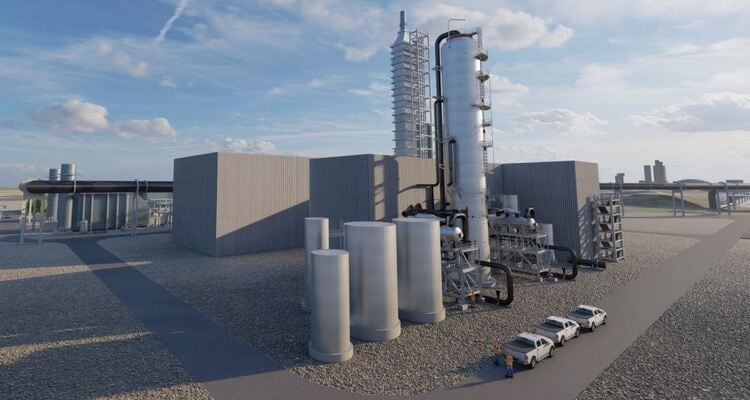Cement is the most-utilized human-made material in the world, and as one of the largest heavy industries, cement manufacturing is responsible for approximately seven per cent of global CO2 emissions. With the global demand for cement expected to grow by 12 to 23 per cent by 2050, carbon capture and storage (CCS/CCUS) provides the most promising, and realistic, solution for slashing emissions from cement and helping the industry realize its goal of producing carbon neutral cement by 2050.
One of the most advanced CCS projects for a large-scale cement plant is underway at Heidelberg Materials’ facility in Edmonton, Alberta, Canada, which began with a feasibility study completed by the International CCS Knowledge Centre and Heidelberg Materials (formerly Lehigh Cement), with funding provided by Emissions Reduction Alberta.
The Knowledge Centre led the completion of a full feasibility study of Heidelberg Materials’ existing Edmonton plant, taking the lessons learned from the development of SaskPower’s Boundary Dam Unit 3 (BD3) CCS facility on a coal-fired power plant, and worked with Heidelberg to study the potential of retrofitting their plant with a similar full-scale, post-combustion amine-based CO2 capture system.
The study provided a guide for the potential to decarbonize cement manufacturing with existing technology – showing that the Heidelberg project could be the first of its kind in the world, with a promising 95 per cent of CO2 expected to be captured from the cement plant and an auxiliary boiler required for capture plant operation.
Approximately one-third of the CO2 emissions produced in the manufacture of cement are generated by the combustion of fuel to heat the plant’s kiln system. The other two-thirds of emissions are generated in the chemical conversion of limestone, so although alternative fuels can conceivably be switched in for the combustion process to reduce emissions, the majority of emissions are a by-product of the manufacturing process and must be captured or otherwise reduced. Currently there is no option for reducing these production emissions, which makes post-combustion CCS an ideal mitigation method for the cement industry in its pursuit of reduced emissions.
Since the original feasibility study was completed, Heidelberg engaged us to support an investigation into the feasibility and economic value of installing a combined heat and power (CHP) facility instead of an auxiliary boiler to generate steam energy for regeneration of the absorbent in the capture plant while also generating electric power. This new work showed a significant improvement in the business case for the CCS retrofit, enough that our team presented the results at the International Energy Agency’s Greenhouse Gas Control Technologies conference in Lyon, France last October.
The intent for Heidelberg in embarking on the study was to have its CCS facility capture its first CO2 before the end of 2026, a plan that would involve not only world-leading technological and engineering innovation, but also drive regional and federal policymakers towards unlocking critical funding. The feasibility study would provide the first level of project validation, analyzing costs and optimal design.
The results showed that a retrofit using existing technology would feasibly capture CO2 for transport to safe and permanent storage in a compatible deep geological saline aquifer. Based on results from BD3, the amine-based carbon capture process was also found to diminish concentration of other pollutants, including significant reduction in particulate emissions.
The study also proposed an innovative combination of wet and dry cooling processes that reduced usage of fresh water and eliminated a potential new wastewater stream from the capture system.
This first feasibility study made a particularly close examination of potential energy needs and ideas around innovative repurposing of excess energy and wastewater. Our contribution to the follow-on work examined the economics of installing an efficient CHP generation system that could further reduce indirect greenhouse gas emissions.
We found that installing a CHP unit to complement the CCS plant can generate additional electric power which provides revenue to support the operating costs of the CCS facility, though achieving this offset requires both a larger CHP plant and a larger CCS unit to treat the increased flue gas flow with a reduced CO2 concentration. The addition of CHP also benefits the overall operation as the CCS facility can continue to operate when the cement plant is undergoing seasonal maintenance or other outages, ensuring more consistent operation of the plant, with fewer stops and starts. It also has the potential to add more clean electricity to the Alberta grid.
More recently, the Government of Canada’s 2023 budget included an extension of the federal investment tax credit for CCUS to include CHP production equipment when a minimum of 50 per cent of the energy is used for the CCS process. We believe this will further bolster the financial viability of CHP projects by enabling them to qualify for a tax credit of up to 50 per cent on associated investments.
The Knowledge Centre is now supporting Heidelberg’s Front-End Engineering and Design (FEED) study, which will advance the system design and procurement to reach a Class II cost estimate.
In the meantime, the future of this innovative project looks bright, as Heidelberg and the Government of Canada recently announced a Memorandum of Understanding to advance the business case for the project. Bringing this innovative CCS project to life will be a real win-win, as it will create 800 full-time jobs and approximately 7,000 person-years of employment through several years of construction, is expected to prevent more than 1 million tonnes of CO2 from entering the atmosphere annually and will help ensure Canada remains a leader in developing large-scale CCS infrastructure.
